top of page

(click on "TRAILING-EDGE" to return to the main menu)
MoTET is an Open-Archive Site Devoted to Research Into The Origins of Personal Computing
%20-%20Copy%20-%20Copy%20-%20Co.png)
. . . and Preserving Yesterday's Technology, for Tomorrow.
_bmp.png)
The Robert A. Ragen Archive
©
.
LAST MAJOR UPDATE: AUGUST 10, 2023
(THIS PAGE IS IN FLUX, IN ITS EARLY STAGES, AND WITH MOST STILL TO ADD)
.
Friden 130 Development
PART 1

Above is the new very high resolution scan of the the same slide as below. The entire archive has been re-scanned, but this is the first to be posted here with the new high resolution scanner.
May 1964
Robert Ragen wrote:"130 with production supervisors" Left to Right: Pete McKenzie, Robert Ragen, 35, Barbro Friden Alexander, Andy Anderson, Bill Poff and Elmer Stoltz (kneeling)
Note: The Pre-Production Prototype appears under plastic (far left).
.

Old Low-Resolution Scan
Robert Ragen wrote:
"130 with production supervisors"
Left to Right: Pete McKenzie, Robert Ragen, 35, Barbro Friden Alexander, Andy Anderson, Bill Poff and Elmer Stoltz (kneeling)
May 1964
.
**Important, Please Read***
Project Origins, in its ongoing exploration of the earliest history of personal transistorized computing, managed to track down and acquire a key historic part of the estate of Robert Ragen, the legendary inventor of the Friden 130. The Friden 130 is regarded by many as the first commercial transistorized desktop calculator. This particular estate portion consists of vast - previously unknown & unpublished - Friden Calculator Company artifacts including prototypes, color slides, audio tapes of key internal discussions, and much more.
Because of its size, the curator will scan/digitize and upload it piecemeal over time, starting with the first two hundred (200) color slide samples (see below) concerning the development of the Friden 130, going back to it's earliest flickerings in May 1961, and giving a near-complete photographic timeline throughout the entire process. Also, posted below are several hours of audio recordings of Robert Ragen and his Team concerning the Friden 130 and the Friden 152. The Friden 152 was the previously unknown printing version of the Friden 130 that led to working prototypes (see and listen below), but never went into mass production. There is a also a protracted behind the scenes discussion and debate over the use of integrated circuits in calculators among the production supervisors and engineers of the Friden 130, together with Friden's freshly minted new President (listen below).
The next intermediate-term posting will be "Ragen's Robots" with a spoiler shown below, chronologically posted under December 1963.
Part 1 of the archive is presented in increasing chronological order from top down the page. Over time, the Project Origins Director and MoTET curator will add discussions concerning each artifact posted.
The below never-before-seen and unpublished photographs (of the original color slides scanned by MoTET) are under copyright protection by MoTET to allow time for the museum to complete its artifact documentation process. Hence, the photographs are watermarked and digitally signed as a kind reminder. When the documentation process is complete, the originals without the watermarks will be swapped in.

.

.
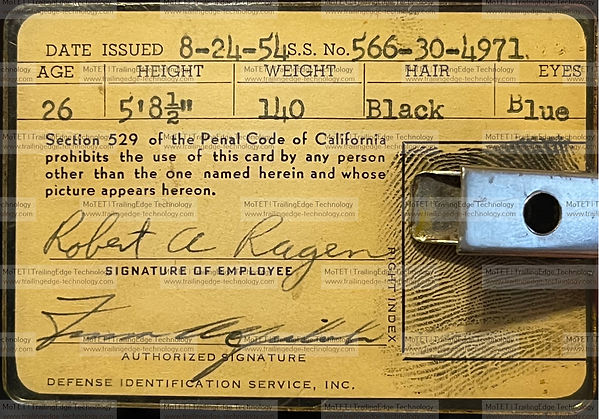
.

.

.

.
.jpg)
.
.
Robert Ragen's Photo Identification badges
Note: Bob's daughter, Pam, remembers Bob wearing the "Singer Friden Division" patch on his lab coat. She also remembers the "ROBERT RAGEN" name plate posted to his office door.
.
_bmp.png)
.
.

.

Before launching into Robert Ragen's Friden-130 Prototype Archive, we first examine some samples of the spark of Bob Ragen's remarkable genius, demonstrating the genesis of his creation and his outside the proverbial box creative process.
Bob was known among domestic family members for his penchant for spontaneous recording of his inventions on napkins, backs of school play programs, trash bags, etc. Photos curtesy of Bob Ragen's daughters.
.

.

.

.

.
_bmp.png)
.
_bmp.png)
.
_bmp.png)
.
_bmp.png)
.
_bmp.png)
_bmp.png)
_bmp.png)
.
_bmp.png)
.
_bmp.png)
April 1961
(below)
E479 & E516-I Development
(EDTC-1 Development)
(Electronic Desk-Top Calculator )

May 1961
(below)

Continued EDTC-1 Development

.

.

.

.

.

.

.

.

July 1961
(below)
SRI Display
(Stanford Research Institute)
Technology Purchased by Friden, from the SRI, for the EDTC-1
%20Display%20-%20IMG00223%20fix_bmp.png)
.

In the close-up the top and bottom row of numbers can be seen "0 1 2 3 4 5 6 7 8 9"
August 1961
(below)
Robert Ragen wrote: "First CRT Display"
Logic, Oscilloscope numerical display, power supplies and keyboard all connected together. On the wall shows the block schematic for the E-479.

.

.

.

Close-up showing the first display. It reads:
9685
8566

.

December 1961
Special thanks to the Ragen family
Just discovered in the Archive!!
.

.

.

.

September to December 1961
(below)
Continued EDTC-1 Prototype Development

.

.

.

.

.

.

.
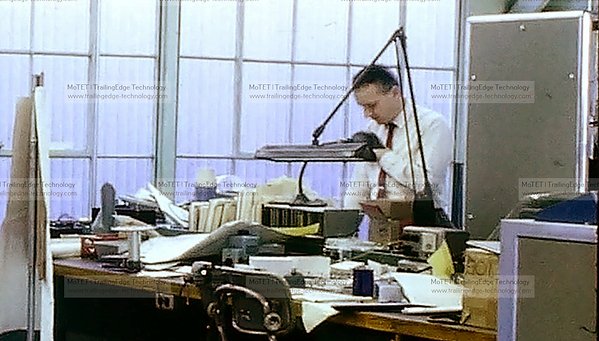
.

.

.

.

.

.

.

January 1962
(below)
Robert Ragen's experimental display. Here it displays "Bob."

February 1962
(below)
Final EDTC-1 Development

.

.

.

.

.

.
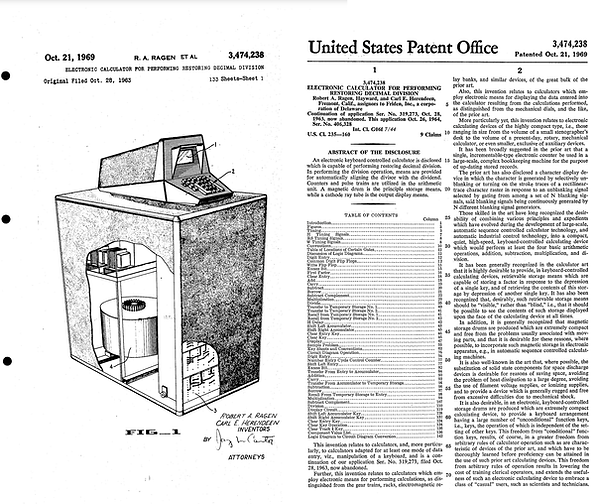%20-%20Copy_bmp.png)
Patent for EDTC-1
Filed October 26, 1964
(2 years 7 months from prototype completion)
Inventors: Robert A. Ragen & Carl E. Herendeen
.

Delay Line Development for EDTC-2 and EDTC-3
.
June 1962
(below)
.

October 1962
(below)
E516-II (EDTC-2) Development

.

.

.

.

.

February 1963
(below)
Final EDTC-2 Development

.

.

.

.

.

EDTC-2 in foreground, and
130 Breadboard (EDTC-3) at the back.
E516-III (EDTC-3) Development
Robert Ragen wrote: "130 Breadboard"
and Console

.

.

.

.

.
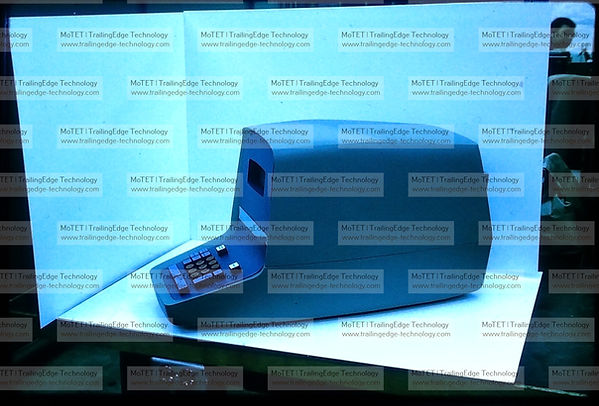
.

.

March 1963
(below)
Final EDTC-3 Development

.

.

.

.

.

.

..

..

Anita Mk 7 in the foreground that was taken apart;
EDTC-1 in the back left with Dean Wackter, and in the back right the EDTC-2 with the full-keyboard and nixie displays.
.
_bmp.png)
Patent for EDTC-3; Filed on October 29, 1963
(after 6 months from prototype completion)
Inventor: Robert A Ragen
May 1963
(below)
_bmp.png)
_bmp.png)
June 1963
(below)
..
_bmp.png)
_bmp.png)
_bmp.png)
June 1963
(below)
Delay line development for the first Pre-Production Prototype

.

.
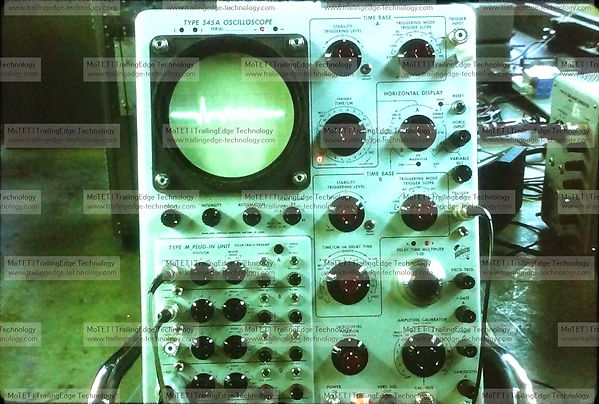
Robert Ragen wrote:
"130 Design Team with 130 without covers"
This is the first pre-production prototype. Dick Ahrens is at the far left. Second from the right is Carl Herendeen the logic designer. I now have confirmation from the Ragan family that the gentleman seated, wearing black, was the Electronic Laboratory Technician named Lou Santos.

.

.

.

First Pre-Production Prototype
and closeup of display
(only the bottom row of numbers can barely be seen with the other three being to faint to see)

.

.

.

.


.
.

"Covers" for the Pre-Production prototype

.

.

.

.

.
First pre-production prototype with covers and closeups of the CRT display.
Only the bottom row of numbers (register) can be seen in the examples below showing the working display of the first pre-production prototype. The other three rows are of lower intensity and can either just barely be seen, or not at all.

.

.

.

"130 in final coverset"
First photograph taken by Robert Ragen of the first pre-production prototype, and still on the lab bench right after the coverset was first put on.
.

.

.

.
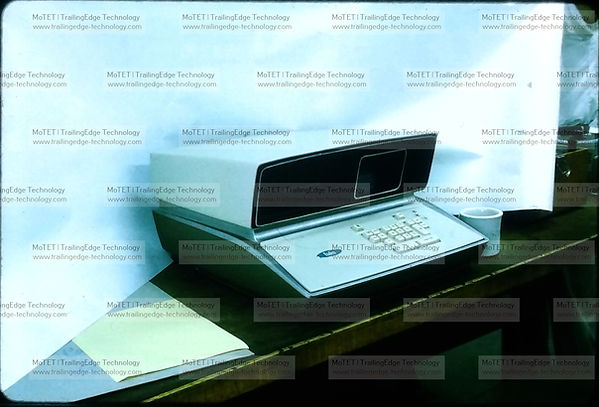
.

.

.

.

.

.

.

.

.

.

.

.

October 1, 1963
(below)
REEL-TO-REEL AUDIO TAPE DIGITIZED
Robert Ragen wrote:
"Mr. Samwell's Talk About Merger and Situation (Roundtable)"
PART-1
**NOTE: On computers you need to unmute the automatically muted browser tab you are using for this site
PART-2
.
.
_bmp.png)

October 1963
(below)
Robert Ragen wrote:
"Display in Final Covers"

November 1963
(below)
130 in the "Final Covers."

Left: Carl Herendeen, the logic designer. The other two individuals are seen on the 130 Design Team photographs. According to the Ragan family, the person on the right was the Electronic Laboratory Technician on the project and his name was Lou Santos, he typically always sits directly in front of the 130 and never wears a tie.
.

Dick Ahrens with the first pre-production prototype
130 with Final Covers (below)

.

.

.

.
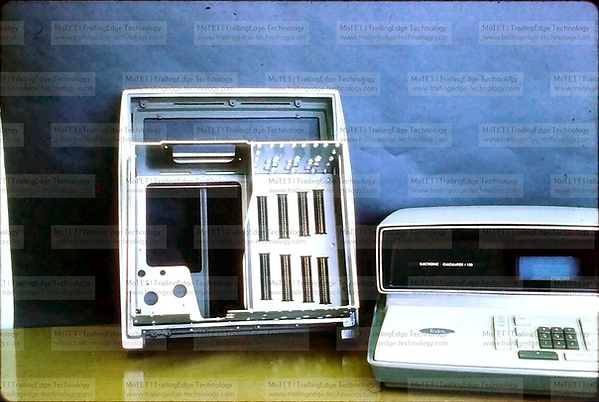
.

.

.

Robert Ragen wrote: "130 boards - PC Cards."
.

Robert Ragen wrote: "130 PC Card."
.

.

Robert Ragen wrote: "130 PC Card."
.

.

.

.

Robert Ragen wrote: "130 Power Supply."
.

Robert Ragen wrote: "130 Circuit Board."
.

.

.

.

.

.

.

.

.

.

.

.

.

.

.

"Ragen's Robots"
This is an 8-image sample from another large segment of this Robert Ragen archive that will be posted later. These are programmable Robots that Robert Ragen designed and developed to test electromechanical calculators. The lady at the bottom is Robert Ragen's Department Secretary, Shirley Backel (taken June 1962).
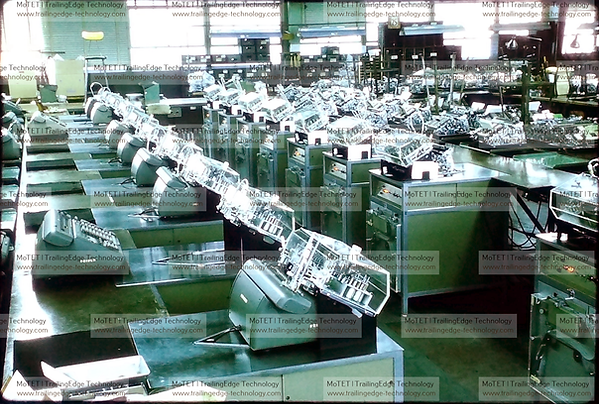
.

.

.

.
Robert Ragen's favorite secretary, Shirley, posing behind one of Ragen's testing robots. Photo by Robert Ragen, June 1962.
.

Bob's secretary, Shirley, is behind the desk typing.
.

This is another one of Bob's secretaries whose name was Carol. Photo by Robert Ragen.
.

This is a later photo taken of Robert Ragen's secretary, Carol. Photo by Robert Ragen.
.

Robert Ragen's last secretary, Raeia Marshall. Photo taken by Robert Ragen.
April 1964
(below)
Robert Ragen wrote:
"130 Production Supervisors"

.

.

.

Andy Anderson (L) and Bill Poff (R)
.

Andy Anderson
.
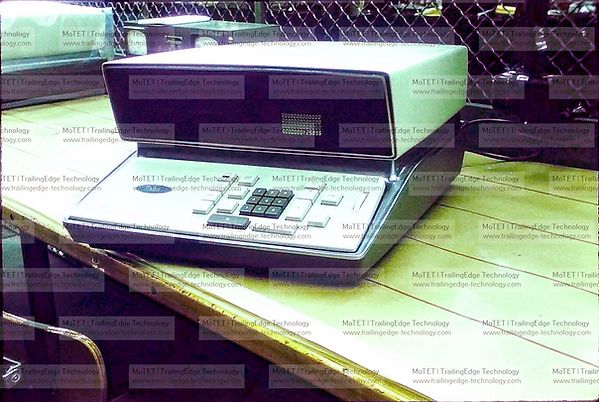
.
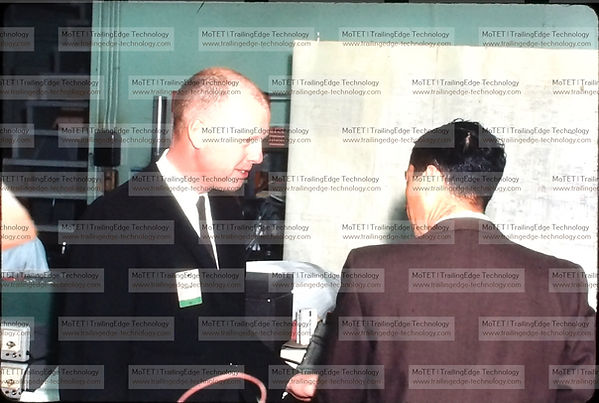
.

.

Staged recreation of earlier EDTC-3 development by the principal engineers themselves
Photos taken by "Paul."

Pete McKenzie (leftmost individual looking directly into the oscilloscope).
.

.

Pete McKenzie (left, foreground and bending over), had a serious verbal stutter, but Robert Ragen immediately hired him when he recognized his talent.
.

Pete McKenzie (left), had a serious verbal stutter, but Robert Ragen immediately hired him when he recognized his talent.
.

Robert Ragen wrote: "STW and 130."

.

.

January 1965
(below)
Robert Ragen wrote:
"130 Calculator Display for Open House"

.

.

.

.

.
REEL-TO-REEL AUDIO TAPE DIGITIZED
Robert Ragen wrote:
Model 152 Talk given by Robert Ragen
During Open House
(New Engineering Build)
PART 1
**NOTE: On computers you need to unmute the automatically muted browser tab you are using for this site
PART 2
"My new office"
Robert Ragen's "new office."

.


.

.

May 1965
(below)
REEL-TO-REEL AUDIO TAPE DIGITIZED
Integrated Circuits Talk Given by Bob Ragen's Assistant. Recorded by Bob Ragen.
PART 1
**NOTE: On computers you need to unmute the automatically muted browser tab you are using for this site
PART 2
PART 3
October 1965
(below)
Electronic Data Terminal for Wells Fargo

.

.

.

.

.

.

.
.

February 1966
(below)
"152 Electronic Printing Calculator"
The Friden 152, shown below, was the printing version of the Friden 132. Robert Ragen wrote that it never went into production. There was also at Friden 152, which was the printing version of the Friden 132.

.

.

June 1967
(below)
More photos of the "Old Friden 152"

.

January 1968
(below)

March 16, 1968
(below)

January 1969
(below)

.

.
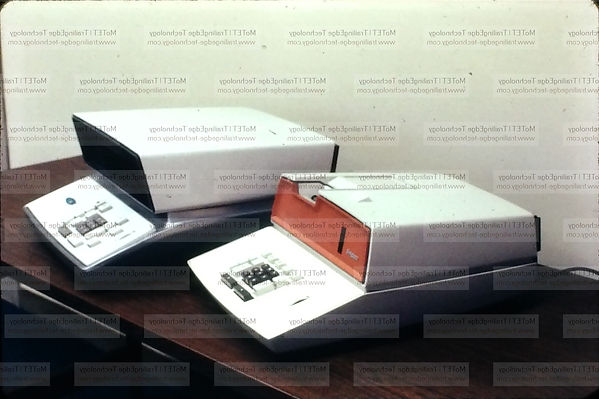
.

October 1969
(below)

Robert Ragen's New Office

.

.

SUPPLEMENTS
(below)
Supplement 1 - Miniature Friden 130 used as an intercom in Robert Ragen's office.
.jpg)
.
.jpg)
Supplement 2: Robert Ragen's cot where he slept in his grandfather's shed that became his childhood workshop.

Supplement 3 - "Charts" from November 1963

Robert Ragen wrote: "Delay Line."
.

.

.

.

.

.

.

.

.

Supplement 4 - "Charts" from June 1964

Logic for EDTC-3
Robert Ragen wrote: "130 Logic."
.

Robert Ragen wrote: "130 Logic."
.

Robert Ragen wrote: "Delay Line Driver Patented"
.

.

.

.

.

.

.

.

.

.

.

.

Supplement 4 - Keyboard Evolution
of the Prototypes

.

.

.

.

.

.

.
.
.
.png)
bottom of page